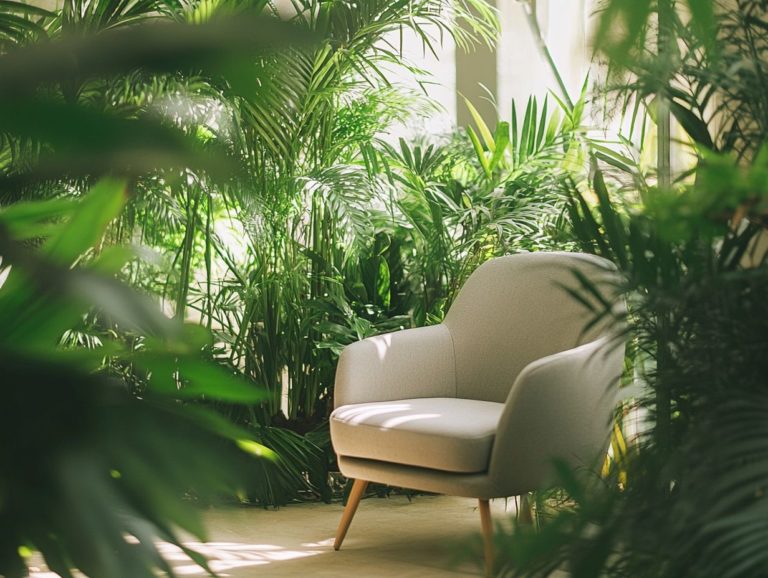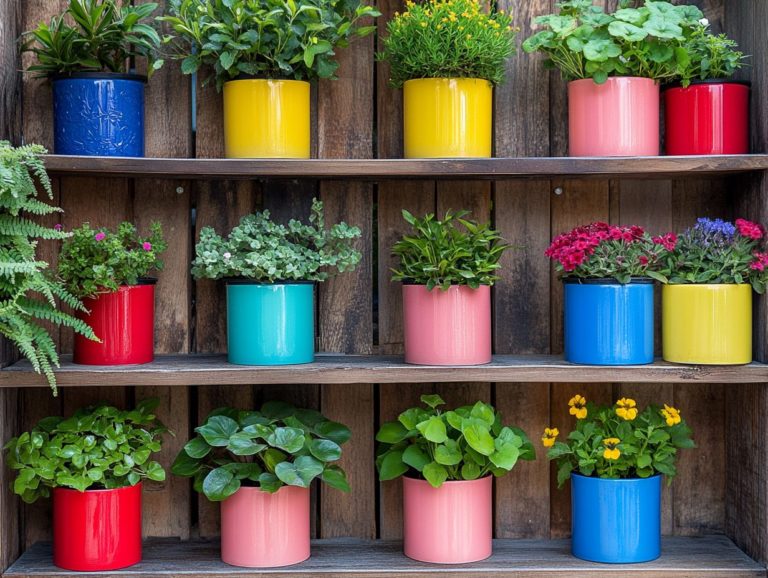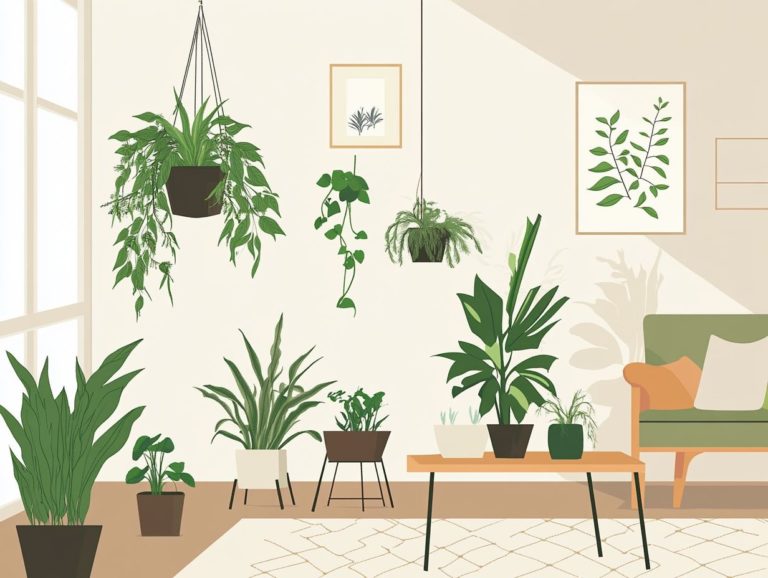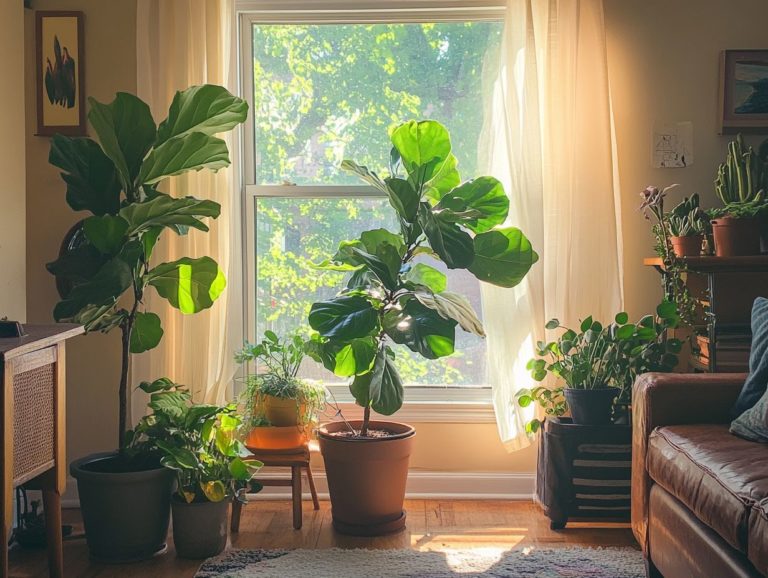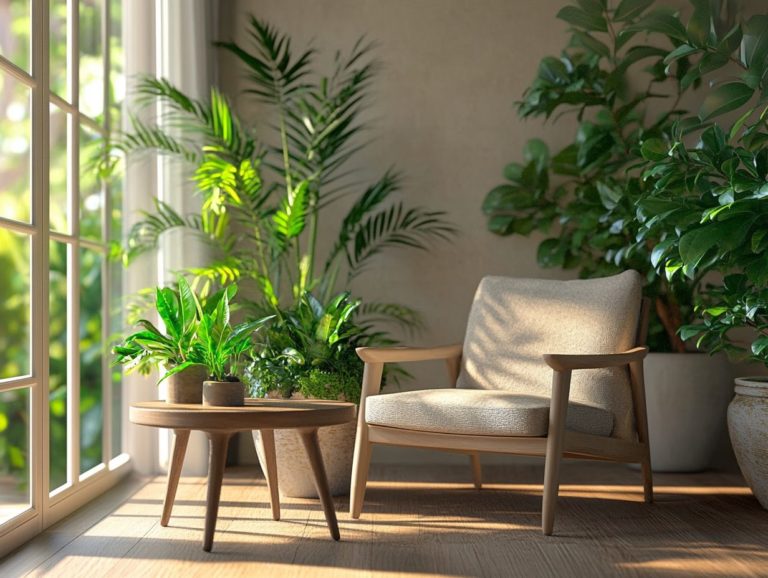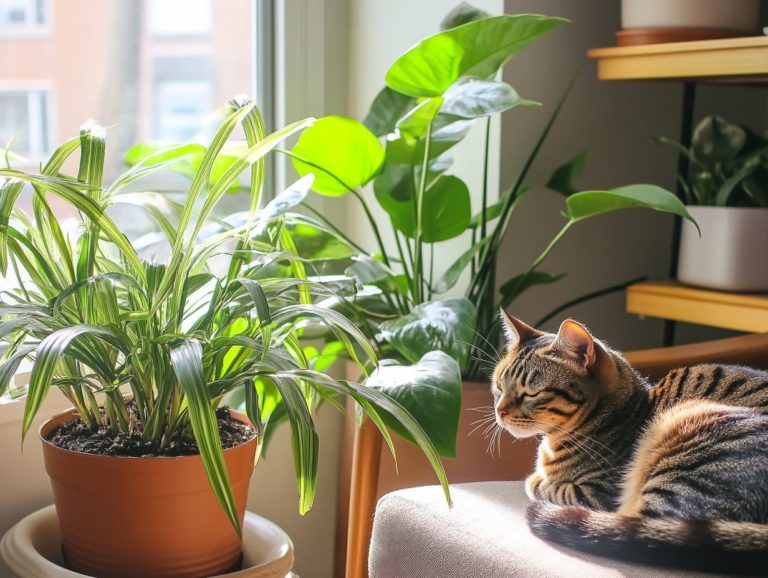Finding the Right Spot for Indoor Plants
Indoor plants, such as the snake plant and pothos, are more than mere decorative accents; they have the power to transform your living space into a healthier, more vibrant sanctuary.
This article delves into the many benefits of incorporating greenery indoors, from enhancing air quality to elevating your mood. You will learn how to select the right house plants based on your home’s unique conditions, uncover optimal placement strategies for light and humidity the amount of moisture in the air and discover tips for arranging them in a visually stunning way.
Essential plant care techniques and solutions for common issues will help ensure your plants thrive. Jump in and see how indoor gardening can transform your home!
Contents
- Key Takeaways:
- Benefits of Indoor Plants
- Choosing the Right Indoor Plants
- Best Spots for Indoor Plants
- Arranging Indoor Plants
- Caring for Indoor Plants
- Dealing with Common Issues
- Frequently Asked Questions
- 1. Where is the best spot to place indoor plants?
- 2. Can I place my indoor plants near windows?
- 3. How do I know if my indoor plant is getting enough light?
- 4. Can I place my indoor plants in dark rooms?
- 5. Are there any spots to avoid when placing indoor plants?
- 6. Can I place multiple indoor plants in the same spot?
Key Takeaways:

- Add indoor plants to beautify your space while improving air quality and boosting your mood. Consider incorporating plants such as Mediterranean herbs like thyme, basil, and rosemary for a healthier and happier environment.
- Choose indoor plants based on light and temperature requirements, as well as your lifestyle and space limitations. This ensures successful plant growth and minimal maintenance.
- Find the perfect spot for your indoor plants by considering their specific light, temperature, and humidity levels. This will help them thrive and add a touch of nature to your space.
Benefits of Indoor Plants
Indoor plants present a wealth of benefits that elevate both the aesthetic charm of your living space and significantly contribute to your overall well-being. By incorporating house plants from a local garden center, you can relish in improved air quality, enhanced humidity levels, and a remarkable uplift in your mood.
These botanical companions do more than just beautify your surroundings; they play essential roles in purifying the air and fostering a serene atmosphere. Additionally, studies have demonstrated their ability to reduce stress and boost productivity, making them a superb enhancement to any indoor environment.
Improving Air Quality and Mood
Indoor plants, like the snake plant and pothos, are your secret allies for enhancing air quality and boosting your mood in any indoor setting.
These hardy species work tirelessly to filter out harmful toxins, such as formaldehyde and benzene, which often lurk in common household products. A study by NASA revealed that certain indoor plants can eliminate up to 87% of indoor air pollutants within just 24 hours. They also naturally increase humidity levels, helping alleviate respiratory issues and enhancing overall comfort, particularly for humidity-loving plants like coffee plants or Boston ferns.
But the benefits don t stop there. Incorporating greenery into your space is linked to psychological perks, such as reduced stress and improved concentration. This makes them more than just a decorative touch they’re a holistic upgrade for your living or work environment.
Choosing the Right Indoor Plants
Selecting the right indoor plants is crucial for cultivating a vibrant environment in your home. Each type of plant comes with its own set of light requirements and care needs, so it s important to choose wisely.
When you visit your local garden center, take a moment to consider factors such as the sunlight exposure in your space, the humidity levels, and how well you can control the temperature. Choose resilient houseplants that can adapt to your unique living conditions, ensuring they not only survive but thrive under your care.
The right selections can elevate both the aesthetics of your home and your overall well-being.
Factors to Consider
When you’re choosing indoor plants, consider a few key factors. These include light requirements, keeping the right temperature, humidity levels, and the best spots to place your plants.
Understanding the specific light needs of your indoor plants is vital for their growth and overall health. Some species thrive in bright, direct sunlight, while others prefer the gentle touch of indirect light or can even manage in low-light conditions.
For example, succulents and cacti typically crave bright, direct light, making south-facing windows their ideal home. On the other hand, snake plants and pothos are celebrated for their ability to thrive in shaded areas, adding a touch of greenery to spaces with minimal light.
By identifying where each plant will thrive, you ensure they don t just survive but truly flourish in your indoor environment.
Best Spots for Indoor Plants
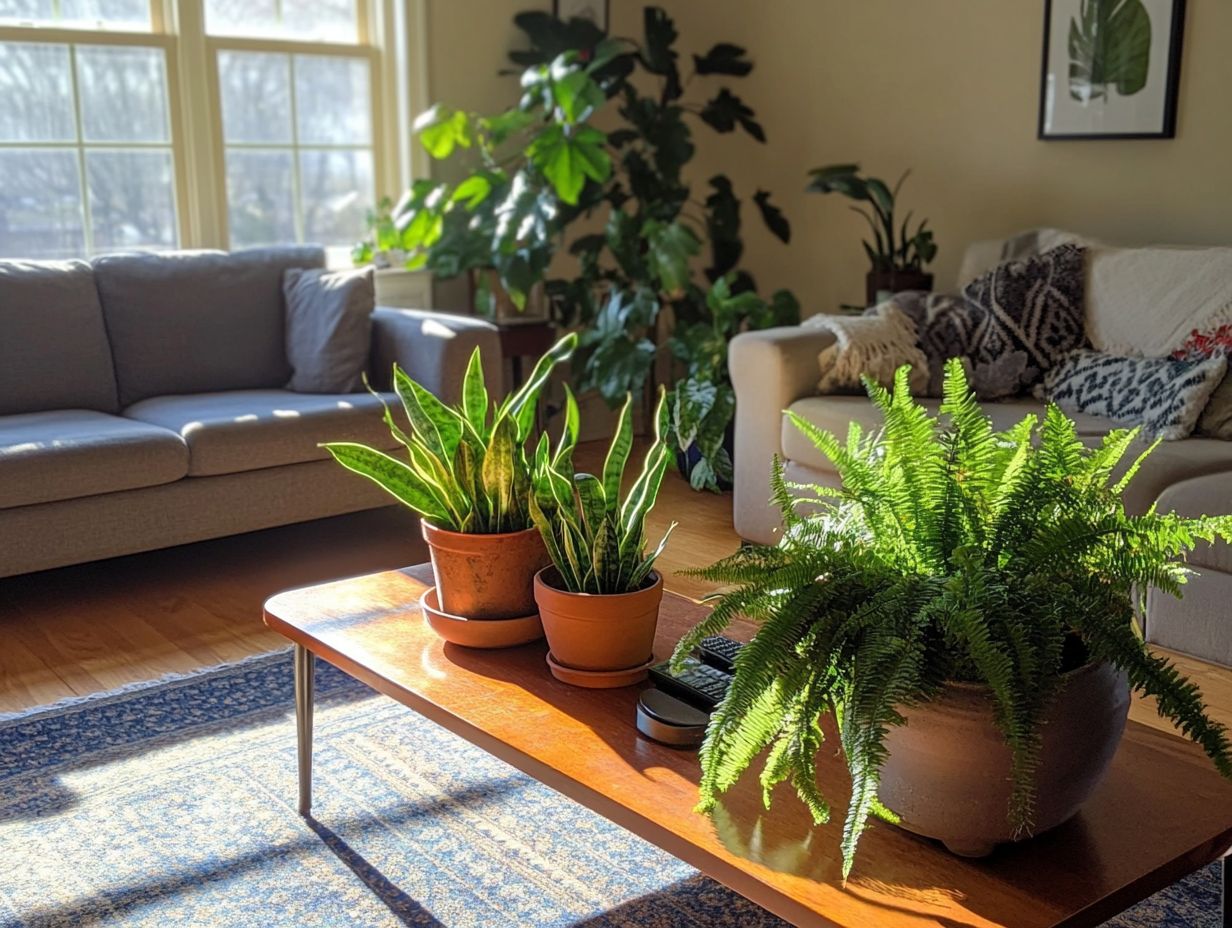
Finding the perfect spots for your indoor plants can make all the difference! Identifying ideal locations is crucial for their growth and vitality, as aspects like light requirements, sunlight exposure, and seasonal changes significantly influence their flourishing.
Each plant has its own preferences; for example, snake plants are quite adaptable and can thrive in low-light conditions, whereas orchids bask in bright, indirect light.
By understanding these unique preferences, you can strategically arrange your houseplants to optimize their access to natural light, which is essential for the process plants use to make food and grow.
Light and Temperature Requirements
Understanding the light and temperature needs of indoor plants is essential for their growth and vitality, as different species thrive under varying light conditions.
If you have succulents or certain cacti, they will thrive in bright, direct sunlight, making a south-facing window their perfect haven. In contrast, varieties like pothos and snake plants prefer indirect bright light to keep their leaves safe from scorching. If you’re nurturing plants such as ferns or peace lilies, you’ll find they excel in low-light conditions, flourishing in spaces where they receive minimal illumination. To better understand your plants’ light needs, check out this guide on understanding indoor plant light needs.
Maintaining a stable temperature is crucial, as fluctuations can stress plants and hinder their development, impacting their vibrancy and overall health. By grasping these nuances, you can create the ideal indoor environment, ensuring that each plant reaches its fullest potential.
Humidity Levels
Humidity levels play a crucial role in the health of your indoor plants, particularly for species like coffee plants, Boston ferns, and orchids, which thrive in higher humidity.
Achieving the right humidity can transform your plant care experience, as a lack of moisture often leads to issues such as leaf browning or stunted growth. If you re tending to these beautiful varieties, it s vital to consider practical methods for maintaining optimal moisture levels.
- Use humidity trays with water and pebbles to create a cozy environment.
- Mist your plants regularly to boost humidity and keep leaves clean.
Many indoor gardeners find success using humidity gauges, allowing for easy monitoring of moisture levels and timely adjustments. By incorporating these plant care techniques, you can cultivate the perfect environment for your cherished indoor foliage.
Arranging Indoor Plants
Arranging indoor plants in a cohesive and aesthetically pleasing manner elevates the beauty of your home while fostering healthy growth for each plant.
Consider the positioning of your plants along with their varying heights and shapes like the tall snake plant paired harmoniously with the cascading pothos to create visual interest and harmony, especially when incorporating the beautiful patterns of Monstera Deliciosa or the striking colors of tomatoes.
By integrating plants into your decor, you not only enjoy the benefits of indoor greenery but also have the opportunity to showcase your unique style.
Creating a Cohesive and Aesthetic Display
Creating a cohesive and visually striking display of indoor plants is all about smart placement and thoughtful selection. This ensures both the health of the foliage and aesthetic appeal.
Consider how color, texture, and size work together among your chosen plants. These elements can create a stunning visual narrative throughout your space. Opt for a variety of leaf shapes and colors think vibrant greens, rich purples, and intriguing variegated patterns to add depth and interest to your arrangement.
Position taller plants at the back or center while allowing shorter ones to grace the front. This creates an eye-catching layered effect.
Pay attention to how each plant grows and ensure they receive adequate light and watering. You ll enhance the display’s visual charm and promote the health and longevity of your green companions.
Caring for Indoor Plants
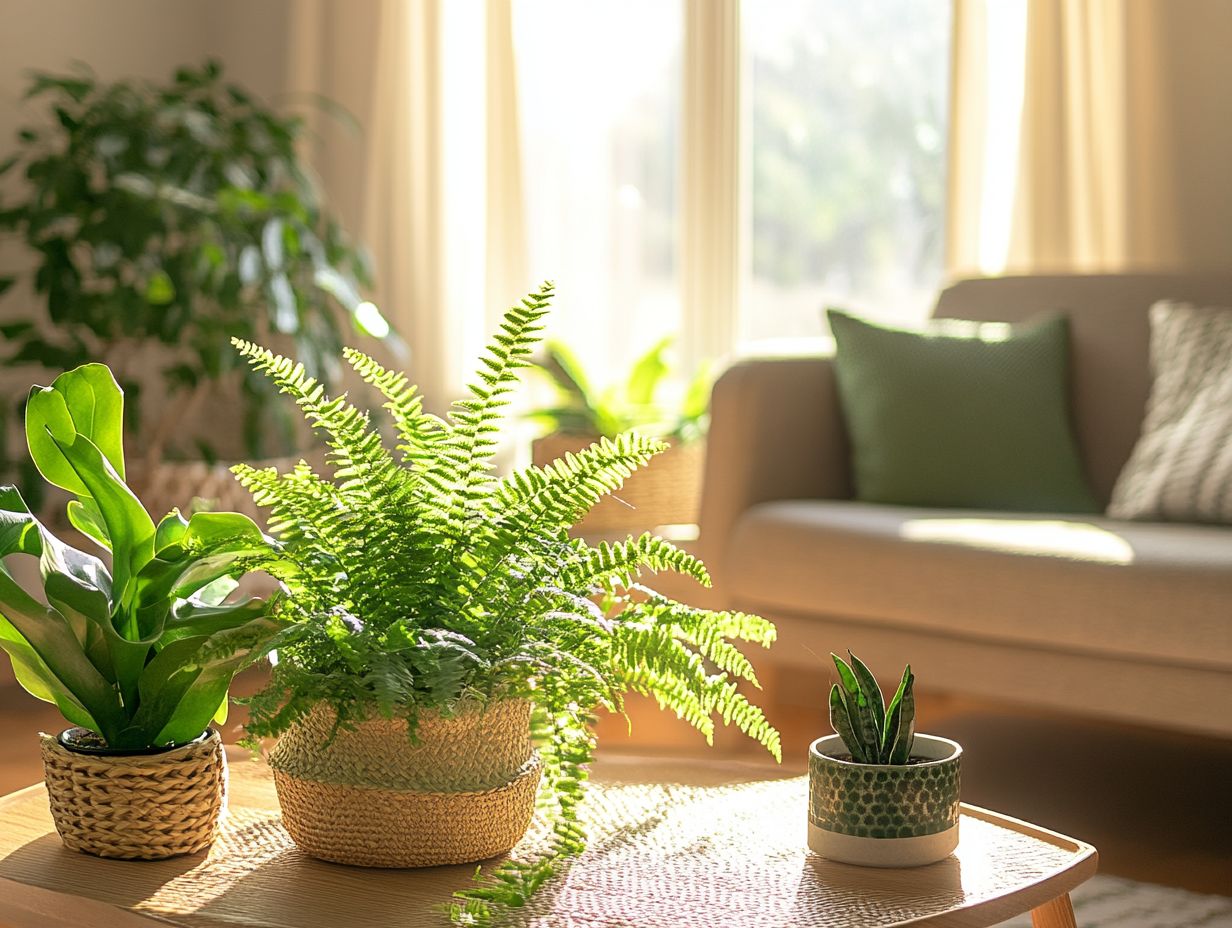
Proper care of your indoor plants is crucial for them to flourish in their environment. This includes meeting their specific watering needs, maintaining appropriate humidity levels, and applying tailored care techniques for each species like the resilient snake plant and the adaptable pothos.
With the right attention, your plants can thrive!
Watering and Maintenance Tips
Effective watering and maintenance are essential for your indoor plants’ health, as their watering needs can vary significantly depending on factors like the season and the specific types of plants you have.
Understand how to meet these watering needs properly. For example, during warmer months, many indoor plants may need more frequent watering due to higher evaporation rates. In contrast, winter often brings reduced light levels and cooler temperatures, meaning your plants will likely need less water.
Watch for signs of overwatering, such as yellowing leaves or a soggy base, to prevent root rot which occurs when roots sit in water and decay. Conversely, underwatering might show up as droopy or crispy leaves. By adjusting your care based on these indicators, you ensure that your plants receive the perfect balance of moisture throughout the year.
Dealing with Common Issues
Managing common challenges like pests and diseases is essential for your indoor plant care regimen. By addressing these issues promptly, you ensure that your greenery thrives, maintaining its health and vibrancy.
Pests and Diseases
Pests and diseases are challenges that indoor plants often encounter. If not addressed quickly, they can seriously impact your plants health and growth.
Common culprits like spider mites, aphids, and mealybugs can stress your beloved houseplants. You might notice symptoms like yellowing leaves, stunted growth, or even a sticky residue on the foliage. Fungal infections, such as powdery mildew or root rot, can wreak havoc on your indoor garden, often appearing as discolored leaves or wilting stems.
Your treatment options vary widely. You can use insecticidal soaps and neem oil to tackle pests, while improving drainage and reducing overwatering can combat fungal issues.
Preventive care is crucial. By ensuring good air circulation, conducting regular inspections, and maintaining the right humidity levels, you can minimize these challenges and keep your plants thriving beautifully.
Frequently Asked Questions
1. Where is the best spot to place indoor plants?
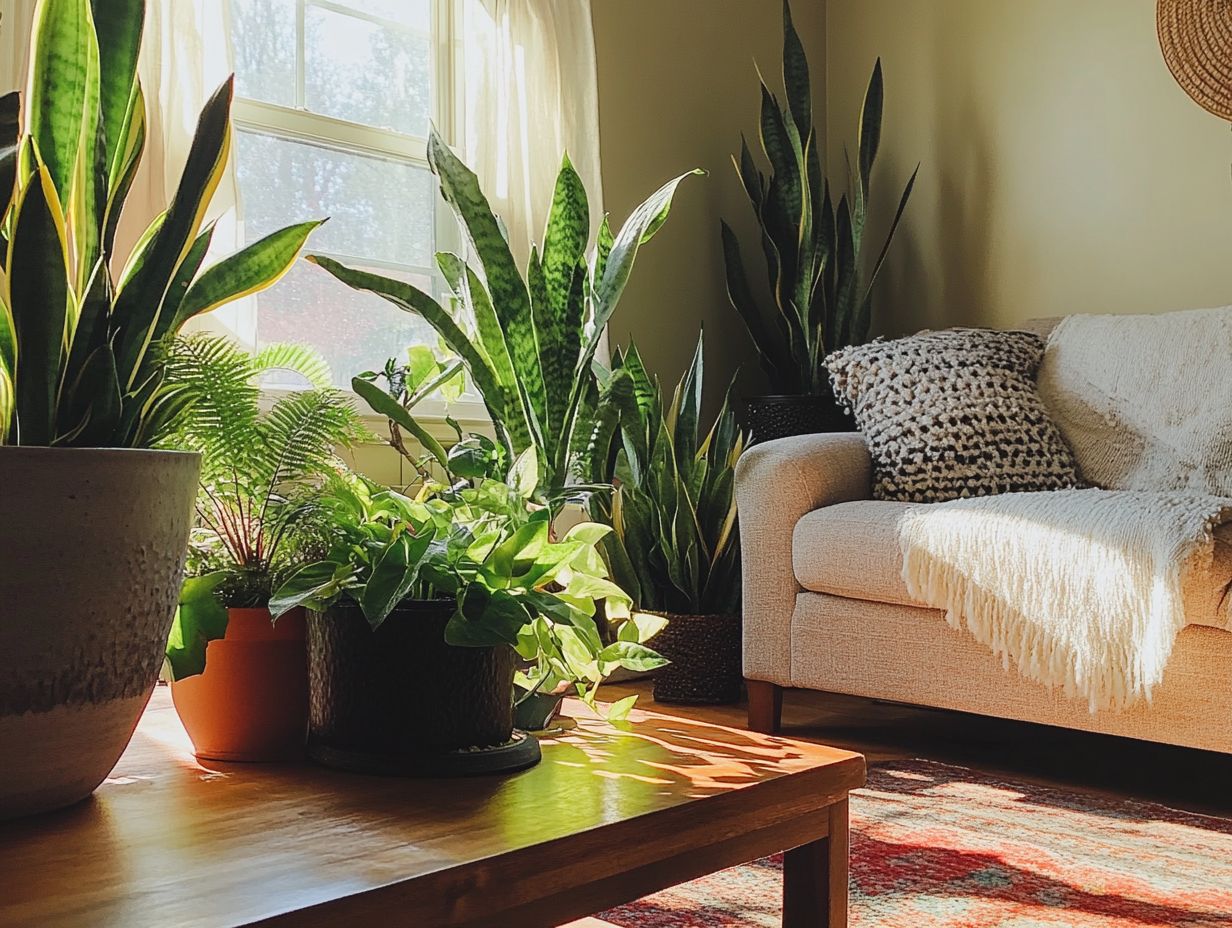
The ideal spot for your plants varies based on their specific light needs. Research your plants to find their perfect place!
2. Can I place my indoor plants near windows?
Yes, it is generally a good idea to place indoor plants near windows where they can receive natural light. However, be cautious of placing them near windows that get direct sunlight, as this can be too intense for some plants.
Explore more about indoor plant care and subscribe for more tips!
3. How do I know if my indoor plant is getting enough light?
Look at your plant’s growth and leaf color. If it’s thriving with vibrant green leaves, it s getting enough light!
If it s not growing well and the leaves are pale or yellow, it may need more light.
4. Can I place my indoor plants in dark rooms?
Some plants can survive in low light, but they won t thrive. It s best to place indoor plants where they can get some natural light to help them grow.
If natural light is scarce, consider using grow lights to keep your plants happy and healthy.
5. Are there any spots to avoid when placing indoor plants?
Avoid putting plants near heating or cooling vents. The constant temperature changes and dry air can harm them.
Also, steer clear of drafty areas, like open doors and windows, to protect your plants.
6. Can I place multiple indoor plants in the same spot?
The answer depends on your plants! Some enjoy being grouped together, while others may need more space.
Remember to rotate your plants occasionally so they receive light from all angles.

